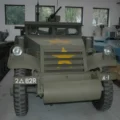
Kurogane Type 95 felderítő autó | |
|---|---|
| Ország | Japán |
| Típus | Felderítő autó |
| Fénykép | Jurij Pasholok |
| Téma | Albuma 144 fotók egy «Kurogane Type 95 cserkészautóról» |
Képgaléria egy Kurogane Type 95 felderítő autó, The Type 95 Kurogane (“Black Metal”) reconnaissance car was a Japanese scout car used during the war with China and World War II in the East. Between 1937 and 1945 approximately 4,800 were built. It was the only completely Japanese designed reconnaissance car ever used by the Japanese Army, which tended to use civilian cars. The Type 95 could accommodate only 3 persons – two in the front and one in the back. The two-cylinder air-cooled petrol engine was an advantage in cold climates encountered in China and it had 4-wheel drive. It was unarmed and unarmoured.
Lásd még:
A Kurogane Type 95 egy könnyű 4×4-es felderítő jármű volt, amelyet a japán hadsereg fejlesztett ki az 1930-as években. Ez volt az egyetlen teljesen japán tervezésű felderítőautó, amelyet a második világháború alatt használtak.
Tervezés és specifikációk
- Hivatalos megnevezés: Type 95 – 4 X 4 Scout Car
- Gyártó: Kurogane (Tokyu Kurogane Industries)
- Gyártási évek: 1936-1944 (kb. 4,700 darab)
- Karosszériastílusok: 2 ajtós roadster, 2 ajtós kisteherautó, 4 ajtós phaeton
- Elrendezés: Első motoros, összkerékhajtású
- Motor: 1,2 l – 1,4 l léghűtéses, OHV 45° V-ikermotoros 2 hengeres
- Teljesítmény: 33 LE (24,6 kW) @ 3,300 ford./perc
- Sebességváltó: 3 sebesség előre, 1 hátramenet
- Méretek:
- Tengelytáv: 2,000 mm (78.7 hüvelyk)
- Hosszúság: 3,600 mm (141.7 hüvelyk)
- Szélesség: 1,520 mm (59.8 hüvelyk)
- Magasság: 1,680 mm (66.1 hüvelyk)
- Saját tömeg: 1,100 kg (2,425 font)
- Végsebesség: 75 km/h (47 mph)
- Hatótáv: 450 km (280 mi)
Funkciók
- Összkerék-meghajtás osztóművel
- Léghűtéses motor ideális hideg éghajlatra
- Magas kerekek durva terepre
- Egyszerű és robusztus kialakítás a terepi körülményekhez
A Type 95-öt a japán erők "Yonki"-nak, azaz "összkerékhajtásnak" és "fekete medálnak" becézték. Nagyobb mobilitást biztosított, mint a motorkerékpárok, és felderítésre, üzenetküldésre és személyzeti szállítási feladatokra használták a csendes-óceáni hadszíntéren.
Views : 4433




